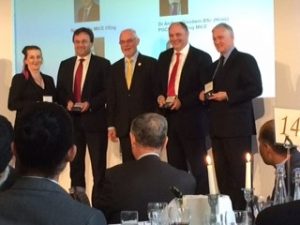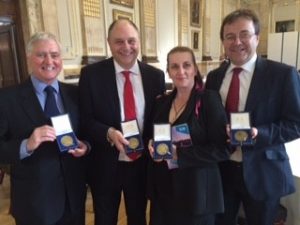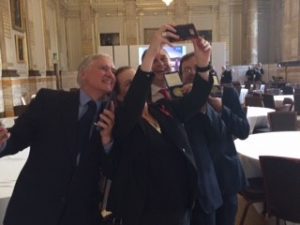We are pleased to confirm that our April 2019 newsletter has just been issued. For those who are not registered on our mailing list, you can download it from here . You can also opt to join our newsletter mailing list by following this link – it takes only a few seconds. Rest assured we never pass your information to third parties, as stated in our privacy statement.
Category Archives: technical papers
HOWARD MEDAL AWARDED
As announced previously, we are very pleased and honoured to announce that on 6 October 2017 our Dr Andy Goodwin, Simon Ellis (Mott Macdonald), Prof Liz Laycock (Sheffield Hallam University) and Dr Chris Hurst (Mott MacDonald) were all awarded the Howard Medal by ICE Publishing for a paper jointly published in 2016. The awards dinner was held at the ICE headquarters near Westminster. The happy recipients are shown below on stage, and both before and after perhaps a little too much champagne!



Entitled “Use of crushed brick in reinforced earth railway structures”, the paper was published in ICE’s Construction Materials Journal. Targeted at improving the sustainability of the development, the work reported on a short practically-focused research project undertaken in association with Sheffield Hallam University with a clear focus on assessing the suitability of crushed bricks to be sourced from a viaduct for re-use as engineered fill. It shows the benefits that can be gained from integrating focused research into a large project.
More details of the project can be seen in the paper, which can be downloaded for free from http://www.icevirtuallibrary.com/doi/10.1680/coma.15.00014.
HOWARD MEDAL WINNER
We are very pleased and honoured to announce that a paper jointly published in 2016 by our Dr Andy Goodwin with Simon Ellis (Mott Macdonald), Liz Laycock (Sheffield Hallam University) and Chris Hurst (Mott MacDonald) has just been awarded the Howard Medal by ICE Publishing. The paper, entitled “Use of crushed brick in reinforced earth railway structures”, was published in ICE’s Construction Materials Journal. Targeted at improving the sustainability of the development, the work reported is based on a short practically-focused research project undertaken in association with Sheffield Hallam University with a clear focus on assessing the suitability of crushed bricks to be sourced from a viaduct for re-use as engineered fill. It shows the benefits that can be gained from integrating focused research into a large project.
More details of the project can be seen in the paper, which can be downloaded for free from http://www.icevirtuallibrary.com/doi/10.1680/coma.15.00014. All of the authors are looking forward to attending the Awards Ceremony in October 2017 and to receiving their medals!
LYME REGIS UPDATE
Following the publication of our joint paper on the stabilisation of a slope at Lyme Regis in 2015 (at the XVI European Conference on Soil Mechanics and Geotechnical Engineering in Edinburgh), readers may be interested to know that a further paper has just been published in Volume 170 of the Proceedings of the ICE, Civil Engineering. Entitled “Stabilising Lyme Regis – a strategic approach” and authored by Roger Moore et al, the paper presents a useful perspective on the range of design and management options available to address coastal instability. It is well worth a read in our view, though we can’t reproduce it here due to copyright. Check it out on pages 63 to 70 of Issue CE2, dated May 2017. A copy can be viewed here if you are an ICE subscriber.
EUROPEAN CONFERENCE PAPER
In September 2015 we had a technical paper published at the XVI European Conference on Soil Mechanics and Geotechnical Engineering in Edinburgh. The paper is based on work undertaken in support of URS (now AECOM) in the design of a coastal protection scheme. Titled “The design of an anchored pile retaining structure to control landslide regression at Lyme Regis, UK”, the authors are Corrado Candian (formerly URS, now COWI), our Andy Goodwin, and Dimitri Daskalopoulos (URS). We are very pleased to have worked with our partners on this paper and look forward to working with them further.

